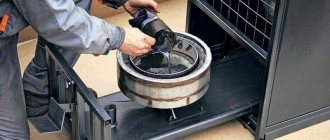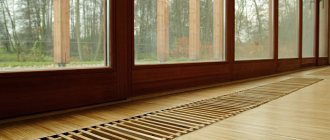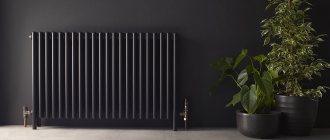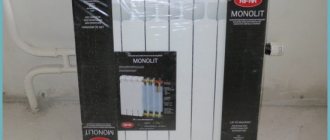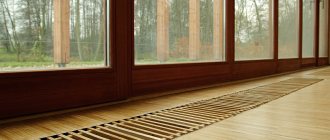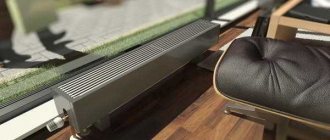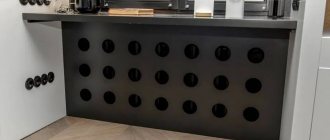A panoramic window is the dream of many. Just imagine a beautiful view from the window of the garden, or the lights of the night city at your feet, clouds running across the sky, and a wide view of the streets or nature. In addition, a room with a panoramic window looks much lighter, more spacious and more interesting than ordinary small windows. In apartment buildings and private estates, huge windows from ceiling to floor are increasingly being installed. Everything is fine in them if the heating is organized correctly. Everyone knows that the larger the area of glass compartments, the higher the level of heat loss.
Warm loggia
Warm loggia
Heated windows. Warm loggia. Warm balcony.
Modern architectural and construction solutions in the field of facade glazing can give any building a special look. Glass structures allow the architect to realize the most original and non-standard projects, and looking at the appearance of urban new buildings, it becomes obvious that the use of glass structures by developers is the most popular trend. This is explained by the fact that façade glazing technology allows you to expand the usable area of residential premises, increase visibility and add natural light to them. The glazed facade gives the house originality and makes it stand out against the backdrop of typical buildings.
Heating of windows and heating of rooms with panoramic glazing.
The appearance and design of heating devices in rooms with stained glass windows, from the point of view of design and functional efficiency, is important, since heaters that are inconsistent with the architectural design can completely destroy it. Conventional panel or aluminum radiators are not suitable in this case.
The reason is not only that they will not fit into the overall design, both internal and external, but also because the surface of the glass is the coldest in the entire room and condensation is likely to form on it. For example, in the kitchen the relative humidity level can reach up to 80%. The dew point value is 18-19°C. If the temperature on the surface of the window is at least 3 °C above the dew point, i.e. about +21 - +24 °C, then the windows will not fog up, in other words, “cry”. Accordingly, in order to prevent condensation from falling on the glass, it is most rational for heating devices to be located along the entire perimeter of the glazing, creating a continuous thermal curtain. Heating windows using warm baseboards is most effective. Warm air rising in a continuous stream along the entire perimeter of window structures will create a reliable thermal barrier and will not allow moisture to condense on the inner surface of the glass.
Warm loggia. Warm balcony.
How to make a loggia warm? Let's consider a popular trend in apartment redevelopment - combining a loggia with an adjacent room, living room or kitchen. Combining a loggia with an apartment is an excellent solution to increase usable space, especially if the dimensions of the apartment are small. Such a reconstruction usually entails special measures to improve the quality of windows, additional insulation of walls, floors and ceilings, since the thermal resistance of enclosing structures should not be lower than building standards (see SNiP thermal protection of buildings). Are you interested in preventing the heat on the balcony from escaping onto the street? Then you can’t do without reliable thermal insulation
Insulating the loggia is very important, since an insufficient level of thermal insulation of the fences will lead in the future to dampness, condensation, the formation of mold, and disruption of the microclimate in the room combined with the loggia, so it is better not to save on insulating loggias and balconies
But insulating the loggia is not all. Thermal insulation is like a person’s clothing; it prevents heat from escaping, but does not produce it. In order for a loggia or balcony to become truly warm, heating must be installed there. The loggia becomes part of the living space, which means the total amount of heat loss will increase, and the heating devices installed in the room initially were not designed for the connected volume and heating the loggia will require additional thermal power. Heating a loggia, taking into account the specifics of the room, will be especially effective using baseboard heating. Uniform heating of the inner surface of the walls will create an additional layer of thermal protection, preventing the formation of dampness in the corners and condensation on the windows.
Insulation of balconies and loggias in combination with installed warm baseboards allows you to achieve the required level of comfort in cold weather. Heating a loggia in urban conditions is most simply and quickly accomplished using the electric version of the baseboard system. A warm electric baseboard can be quickly installed even in winter, when the lack of heat on the loggia is especially noticeable, and electric heating does not require preparatory work.
Tools and consumables for work
The owner of panoramic windows who has decided to carry out insulation must weigh his technical and financial capabilities and choose a specific heating system option. Most often, a home craftsman can independently insulate slopes, install warm baseboards and a “warm floor” system.
To do this, he will need to prepare the following tools and consumables :
Insulation of slopes:- Penoplex insulation;
- glue;
- façade mesh;
- different spatulas;
- knife;
- hammer;
- roulette;
- ruler;
- corner;
- primer;
- putty;
- corner with reinforced mesh.
- Warm baseboard and heated floor:
- heating elements;
- wires;
- connecting box;
- circuit breaker;
- screwdriver;
- tester;
- fasteners;
- protective panels;
- drill, grinder;
- roulette;
- level;
- For a water heating element you will need:
- pipes and fittings, circulation pump;
- soldering iron for welding pipes;
- perforator;
- dowels;
- set of wrenches;
- safety fittings to shut off the heating system in the event of an accident.
Heating options for windows
When conventional radiators do not fully cope with the functions assigned to them or a different type of heating system is used in the premises, it is recommended to install heated windows to ensure comfortable conditions. Thanks to this solution, it is possible to minimize heat leakage and maintain optimal temperature conditions in the rooms at the lowest possible cost. There are several options for heating windows on the market, so you can always choose the most suitable one.
In what cases is it recommended to use heated windows?
If the window openings have a large area, then it is definitely better to immediately install heated windows, since the flows emanating from the radiator are not able to create an effective thermal curtain. These models are also recommended when rooms are heated:
- heated floor system;
infrared heaters installed outside window openings;
warm air through ventilation ducts;
fireplaces, etc.
In all of the above cases, there are no full-fledged thermal curtains opposite the window openings, which can provoke a whole list of negative consequences:
- rapid decrease in temperature in the rooms;
excessive condensation;
the appearance of fungus and mold on various elements of window structures.
Aluminum, wooden and plastic heated windows do not have such problems. In addition, they not only help create comfortable conditions for living and working, but also allow you to significantly reduce heating bills.
Window heaters
These products are designed to slow down the process of heat exchange between indoor spaces and the street. They also allow you to additionally warm the air in the rooms, thereby reducing the load on the central heating system.
Today, window heaters are represented by two types of devices:
- infrared elements - devices whose operation does not generate air currents, since they heat objects located in their area of action;
air thermal curtains - such a window heater supplies a powerful stream of air heated to a certain temperature parallel to the opening, due to which an additional invisible barrier is created between the room and the street.
Such devices not only retain heat and heat the rooms, but also prevent the appearance of drafts that can occur if the windows are slightly depressurized.
Flexible window heating system
Infrared elements and thermal curtains are generally effective, but have some disadvantages. For example, they require space for installation, sometimes create noise and in some cases have a negative impact on the interior. European engineers have figured out how to make a quiet and unnoticeable device that prevents windows from cooling. Its work is based on thin heating elements, which are a flexible tape that runs along the perimeter of the glass unit. Such a system consumes little energy and increases the temperature of the glass unit, eliminating cold bridges in both blind and active sashes.
In addition to being economical and compact, this system is suitable for windows that are already in use. Thanks to the minimal thickness and flexibility of the heating elements, it is possible to remove the glass unit from the frame, wrap it in tape and insert it back, and then connect it to the control unit. This device prevents condensation from forming and slows down the heat transfer process. Its integration guarantees the absence of frost on the windows even at very low temperatures.
The flexible system is best suited for openings with relatively small dimensions, since it slightly heats these products only around the perimeter. If significant heat loss through the windows is expected, then it is better to use a device that is able to heat the glass over its entire area.
Heated double-glazed windows
Recently, there has been an increase in demand for windows in which heated double-glazed windows are installed, capable of creating a thermal curtain directly in the air chamber itself. Their operating principle is based on heating a special coating, evenly distributed over the entire area of the glass, with the passage of electric current. A detailed review of these models has been published on OknaTrade. This modification will cost more than the two previous devices, but it is much more advanced and compact than heaters and more functional than flexible heating tapes. In Russia, heated double-glazed windows are recommended for installation in regions with harsh climates, as well as glazing of verandas, terraces, winter gardens and swimming pools.
What to do
The question is not rhetorical: some of the problems I listed with French windows are completely solvable.
Heating
A low (200 - 350 mm) sectional radiator, a warm baseboard (the so-called wall convector with a height of 13 - 18 cm decorative screen) or an in-floor convector installed in a screed or between floor joists can create a thermal curtain in front of a panoramic window.
Panoramic window with in-floor convector.
My thermal curtain is created by an internal split unit blowing parallel to the plane of the window - a system that is the only source of heat in the attic.
The thermal curtain is created by an internal split system unit installed next to the window.
Cold, overheating and excessive light
These problems can be successfully solved by installing a combined double-glazed window with one energy-saving and one solar control glass.
What kind of glass is this?
Thanks to a thin metal coating, solar control glass reflects part of the light in the visible part of the spectrum (from 30 to 70%), reducing the illumination of the room and its heating in the summer heat.
By the way, it will also save you from prying glances from the outside thanks to the mirror effect. The interior of the room will be visible from the street only at dusk and when the lights are turned on inside.
Cottage with light-protective glass.
Energy-saving glass is equipped with the same metal coating, which, due to its special chemical composition, has limited transparency only in the infrared part of the spectrum. Glass reduces heat loss in winter, when the temperature in the house is higher than outside, and limits the heating of rooms in sunny weather.
Glass is easily recognized by the color of the reflected fire.
A single-chamber double-glazed window with one energy-saving glass transmits a quarter less heat than a double-chamber double-glazed window with conventional glass.
Double-chamber double-glazed window with energy-saving and light-protective glass.
If the windows are already installed, you can turn the double-glazed windows into solar-protective and/or energy-saving ones by sticking appropriate films on the glass.
The film can change the characteristics of your double glazed window.
How to do it yourself? The instructions are extremely simple:
- Wash the glass;
- Cut the film to the size of the glass unit;
- Wet the glass generously with water and a small amount of baby shampoo;
- Remove the film from the backing, press it against the glass and smooth it with a rag or rubber spatula from the center to the periphery, driving out the water.
The film is glued to heavily moistened glass.
The noise problem can be partially solved by installing a noise-proof double-glazed window. Sound insulation is achieved by combining glass of different thicknesses (usually 4 and 6 mm) with variable thickness of spacer frames. As a result, the glazing absorbs sounds across the widest possible acoustic spectrum.
Regular and noise-proof double-glazed windows.
Features of arranging transparent walls
The arrangement of transparent walls that decorate the exclusive interior of the room is accompanied by taking into account a number of important nuances.
- A lot of thermal energy is lost through large window structures, changing the microclimate of the room.
- The difference in parameters of external and internal temperatures forms the air space where cooled flows move.
- In winter, frosty patterns appear, rising temperatures condense vapors, which, after flowing down, become an excellent habitat for harmful fungi.
Preserving the aesthetic appeal of the panoramic glazing design is achieved by assembling a special heating system.
Criterias of choice
Water systems are more difficult to work with; several additional factors may influence the purchasing decision, in addition to the dimensions and material from which the body, fins and pipes are made.
The first thing you should pay special attention to is the overall pressure level in the heating system. For private buildings and cottages, absolutely any model will do, since the pressure here rarely exceeds 3 atmospheres
But owners of apartments in high-rise buildings should add pressure testing and operating pressure of the heating system. Experts recommend installing devices rated at 15 bar. Coolant parameters. Here the approach is similar: for individual heating systems, a variety of designs can be used, since only the owners of the house set the required temperature conditions, but the owners of apartments in high-rise buildings are forced to adapt to what flows in their pipes. Moreover, this concerns not only the degree of heating, but also the presence of all kinds of suspensions, oxygen content and connection method. Therefore, it would be right to first get acquainted with the recommendations for specific types of coolant, and then compare them with the parameters of the heating device.
Type of system and connection diameter Most often, varieties of floor radiators are equally effective in both single-pipe and double-pipe systems, however, there is no rule without exception, so it is necessary to pay attention to this point
The diameter should also be taken into account, but this factor cannot be considered critical, since nowadays the market is overflowing with all kinds of adapters, so any sizes can be “adjusted” to each other. It is very important to think in advance what material the radiator should be made of under specific operating conditions. If the room is dry, then you should not purchase a product with a stainless steel body, since the quality of such material sometimes raises serious doubts. Of course, world-famous brands produce their heaters only from the best steel, but cheaper analogues often use so-called technical stainless steel, which significantly loses in its performance characteristics.
Bimetallic devices for panoramic windows
This type of radiator belongs to heat supply equipment, the high cost of which best corresponds to the quality.
Bimetallic radiators differ:
- High working pressure.
- Compatible with other metals. In them, aluminum is used only for the manufacture of the shell, which increases the aesthetics of appearance and heat transfer. As for the internal casing, equipped with outlets for connection to the system, it is made of stainless steel or black steel.
The height of bimetallic radiators for panoramic windows ranges from 24.5 to 45 centimeters.
Conclusion: which batteries to choose?
For a small room or a room with a long window, choose low radiators. If space allows, a universal solution is vertical steel tubes. They are the most practical, easy to use, and beautiful.
If your budget is above average, explore designer lines: manufacturers such as the Italian brand IRSAP offer a lot of non-standard options. The battery can become an unusual decorative element that will add zest to the interior.
Sources
- https://vencon.ua/articles/osobennosti-otopleniya-pomeshcheniya-s-panoramnymi-oknami
- https://mr-build.ru/newteplo/otoplenie-panoramnyh-okon.html
- https://evrookna-mos.ru/kak-vybrat-radiator-pri-panoramnom-osteklenii.html
- https://www.tproekt.com/nizkie-radiatory-otopleniya/
- https://okna-dom.net/pravilnaya-ustanovka-radiatora-otopleniya-pod-oknom/
- https://okno-pro.ru/balkony/obogrev-panoramnogo-ostekleniya-2.html
The best heating for panoramic glazing
The Warm Plinth system is recommended for installation under floor-to-ceiling windows.
Panoramic glazing, floor-to-ceiling windows, and a picturesque view from the window are signs of elite modern housing and are mostly represented in business-class housing and penthouses.
Panoramic windows have both pros and cons. Glass “walls” provide maximum daylight. Large windows let in a lot of sunlight and heat, but in summer an excess of sunlight leads to the fact that the room is very hot, and in winter, on the contrary, it is cold, since a large glazing area means significant heat loss.
The thermal conductivity of glass is significantly higher than the thermal conductivity of walls. Therefore, it is necessary to use more energy-efficient window systems and increase the heating intensity of the room.
It is most optimal to install heating equipment around the perimeter of the window unit to help the windows warm up from the inside and raise the surface temperature of the inner glass above the dew point. However, installing a convector or radiator against the background of panoramic glazing will significantly spoil the aesthetics and will look ridiculous with a radiator in the center... In-floor convectors require construction preparatory work and are quite expensive. Thermal curtains with top and side placement are not friendly to physics...
Floor convectors
Another common way to heat a room with panoramic windows is to install floor convectors. This option is simpler than in-floor ones in terms of installation - you don’t need to prepare a special niche on the floor, just place the model in the area next to the power source.
Among the advantages of floor heaters are:
- compactness and stability. Many models are equipped with durable legs that support the entire structure;
- small dimensions. Thanks to the design features, it is possible to create very miniature models;
- ease of operation and maintenance. There are no difficulties, everything is very easy.
But there is also a drawback: such heaters do not provide enough heat; they can be used as auxiliary equipment.
Low radiators
A worthy replacement for standard radiators will be their low variety - they are in no way inferior in quality, but at the same time they do not visually burden the interior at all and leave a fairly wide viewing angle.
They can be installed directly in front of double-glazed windows: they protect against condensation and drafts. It is very important to choose the model that will be ideal for your home. For example, cast iron batteries take a long time to heat up, but at the same time they hold high temperatures very well and on average last up to 50 years
Steel and aluminum heat up faster, but at the same time they do not please with their strength. Bimetallic models can be considered the best option - they combine both good heating and high strength.
Standards for installing batteries in residential premises
According to building codes and regulations, the battery under the window opening must be installed taking into account the following requirements:
- the heating radiator should be installed at a height of 80-100 mm from the floor;
- relative to the window sill, the radiator is placed 100-120mm lower;
- The battery must be placed at a distance of 30-50 mm relative to the wall;
- the battery should be located in the center of the window opening.
How to properly hang a heating radiator determines how easily you can maintain order in the room and how well it will warm up during the heating season. The distance above the floor level and from the window sill during the heating season ensures natural air convection. As it rises, it cuts off the cold flow from entering the room and creates a heat shield in the window opening. The gap between the floor and the lower edge of the heating radiators makes it possible to carry out cleaning, which is very important for residential premises.
The convector under the window sill should be 3-5 cm lower than it. This ensures air circulation, on the one hand, and on the other hand does not allow dust to accumulate in this space. The central location of the radiators allows the window units to be covered with a flow of warm air, blocking the penetration of cold into the room.
Heating systems as an interior element
Each model line of heating equipment has a segment where radiators of small height are presented. This group includes products in which this parameter does not exceed 450 millimeters. A low heating radiator under a window is indispensable for heating constantly wet and cold walls facing the street along their entire length.
Such devices are used in the following cases:
- the presence of large panoramic windows;
- location of the heat supply system in the baseboards.
When choosing heating equipment, you need to take into account a number of technical parameters of the products:
- material of manufacture;
- dimensions;
- power;
- resistance to corrosion processes;
- scope, etc.
Materials used
Bimetallic products are the most durable due to the characteristics of the coolant movement.
Based on the type of material used in manufacturing, radiators for French windows are divided into the following types:
- Cast iron batteries produced by casting and representing a continuous heating section.
- Steel structures assembled from individual plates in combination with a pipe base.
- Aluminum radiators produced by casting or extrusion.
- Bimetallic products, in the manufacture of which two metals of different structure and characteristics are used.
Cast iron is a brittle material, which limits the permissible water pressure inside the battery sections. In addition, due to the rough surface, various contaminants accumulate on their internal planes, reducing the effect of heat transfer. On the other hand, cast iron water radiators retain heat well within the working area and are not subject to the destructive effects of salts dissolved in the coolant.
The design features of steel batteries, assembled from individual plates, make it possible to increase the level of convection and heat transfer. But they are also the reason for the frequent formation of blockages in the places where the plates are attached to the tubes.
The main advantage of an aluminum-based battery is its low weight and the ability to “hold” increased coolant pressure. On the other hand, their convection performance is worse than that of products made of cast iron and steel. In addition, aluminum is not as strong as other metals and is not designed to withstand frequent water hammer.
Bimetallic radiators, which combine two different materials, are usually made of copper tubes with aluminum or steel plates placed on them. The pipe base of such a product can withstand pressure corresponding to several tens of atmospheres. At the same time, it is not subject to the destructive effects of the coolant, long-term contact with which is not a problem for copper.
The service life of such batteries is comparable to that of a cast iron product.
Bimetallic radiators are not too large in size, however, due to heat loss in the areas where the plates are attached, the heat transfer efficiency is slightly less than that of their aluminum counterparts.



